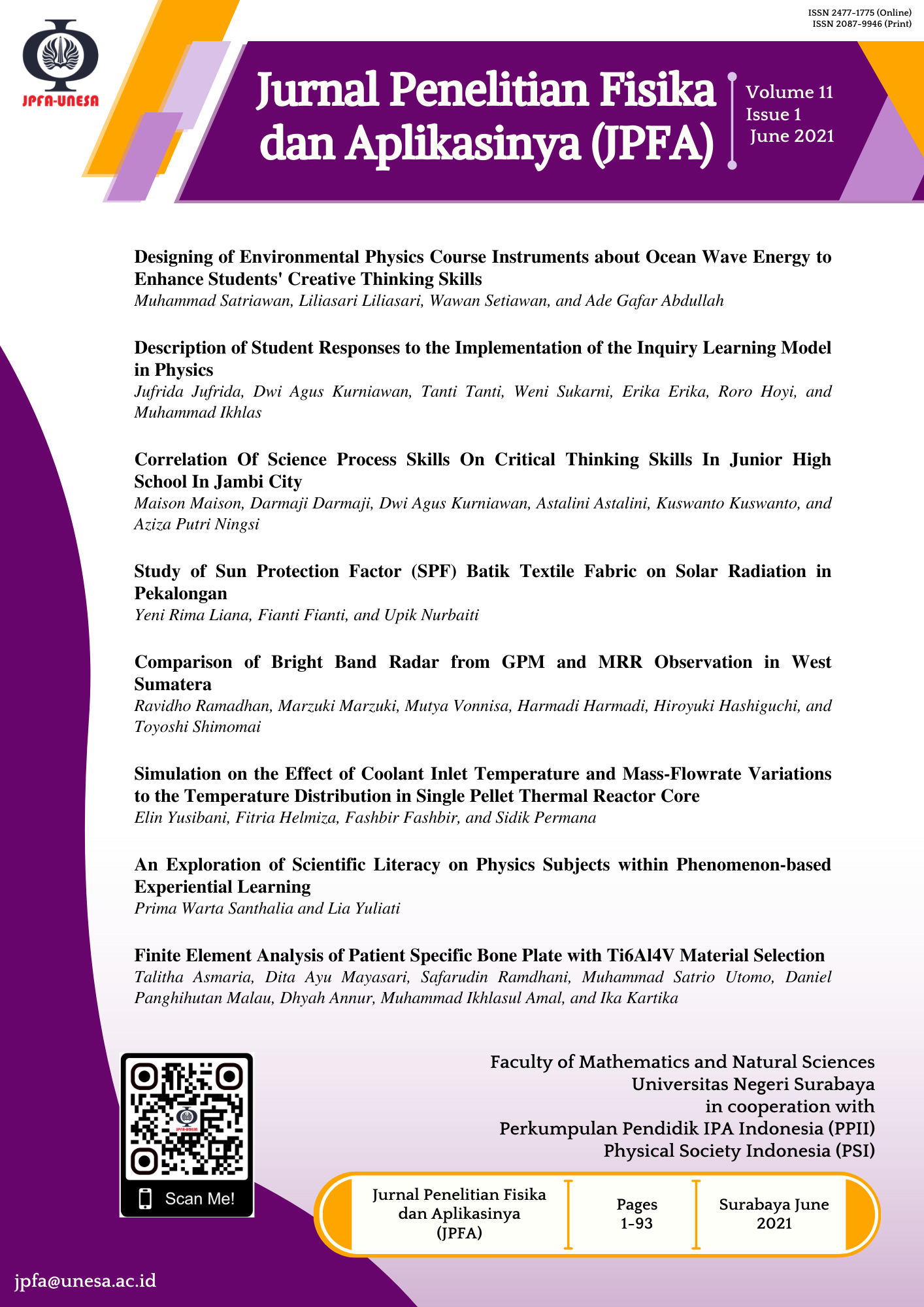An Exploration of Scientific Literacy on Physics Subjects within Phenomenon-based Experiential Learning
DOI:
https://doi.org/10.26740/jpfa.v11n1.p72-82Keywords:
scientific literacy, phenomenon based experiential learning, expansionAbstract
Abstract
Scientific literacy is the ability to involve yourself in problems related to science. This research explores students' scientific literacy skills in experiential learning based on phenomena on the concept of expansion. This research was conducted with a mix-method approach with an embedded experimental model design. The data were collected through scientific literacy tests (r = 0.53), and open-ended questions interviews with the students, then analyzed using the Mann-Whitney U-Test quantitatively, and using the Bybee (1997) assessment rubric qualitatively. Based on the results, it was found that the majority of students experienced an increase in their scientific literacy from the SI (Scientific Illiteracy) category (96.88%) into CSL (Conceptual Scientific Literacy) (46.88%). We concluded that phenomenon-based experiential learning was effective in improving students' scientific literacy. So, we need more effort to improve and increase students' scientific literacy skills by integrating scientific literacy competencies while implementing science learning in schools.
References
Yeo J, Lim E, Tan KCD, and Ong YS. The Efficacy of an Image-to-Writing Approach to Learning Abstract Scientific Concepts: Temperature and Heat. International Journal of Science and Mathematics Education. 2021; 19: 21-44. DOI: https://doi.org/10.1007/s10763-019-10026-z.
Irawati RK and Sofianto EWN. The Misconception Analysis of Natural Science Students on Heat and Temperature Material Using Four Tier Test. Journal of Physics: Conference Series. 2019; 1321(3): 032104. DOI: https://doi.org/10.1088/1742-6596/1321/3/032104.
Yuliati L, Parno, Yogismawati F, and Nisa IK. Building Scientific Literacy and Concept Achievement of Physics through Inquiry Based Learning for STEM Education. Journal of Physics: Conference Series. 2018; 1097: 012022. DOI: https://doi.org/10.1088/1742-6596/1097/1/012022.
Pahrudin A, Irwandan, Triyana E, Oktarisa Y, and Anwar C. The Analysis of Pre-Service Physics Teachers in Scientific Literacy: Focus on the Competence and Knowledge Aspects. Jurnal Pendidikan IPA Indonesia. 2019; 8(1): 52-62. DOI: https://doi.org/10.15294/jpii.v8i1.15728.
Reddy D. Scientific Literacy, Public Engagement and Responsibility in Science. Cultures of Science. 2021: 1-11. DOI: https://doi.org/10.1177/20966083211009646.
Howell EL and Brossard D. (Mis)informed About What? What It Means To Be a Science-Literate Citizen in a Digital World. Proceedings of the National Academy of Sciences of the United States of America. 2021: 118(15); e1912436117. DOI: https://doi.org/10.1073/pnas.1912436117.
https://doi.org/10.15294/jise.v9i3.43539.
https://doi.org/10.29333/iji.2021.14349a.
Wenning CJ. Experimental Inquiry in Introductory Physics Courses. Journal of Physics Teacher Education Online. 2011; 6(2): 1-8. Available from: http://www2.phy.ilstu.edu/~cjwennin/jpteo/.
OECD. PISA 2015 Results in Focus. OECD Publishing; 2018.
May S, Jang-Jones A, and McGregor A. PISA 2018: New Zealand Summary Report 2019.
Dewi CA, Khery Y, and Erna M. An Ethnoscience Study in Chemistry Learning to Develop Scientific Literacy. Jurnal Pendidikan IPA Indonesia. 2019; 8(2): 279-287. DOI: https://doi.org/10.15294/jpii.v8i2.19261.
Jufri AW, Setiadi D, and Sripatmi. Scientific Reasoning Ability of Prospective Student Teacher in The Excellence Program of Mathematics And Science Teacher Education In University of Mataram. Jurnal Pendidikan IPA Indonesia. 2016; 5(1): 69-74. DOI: https://doi.org/10.15294/jpii.v5i1.5792.
Kolb AY and Kolb DA. Experiential learning: experience as the source of learning and development. New Jersey: Pearson Education, Inc.; 2015.
Bybee RW. Achieving Scientific Literacy : from Purposes to Practices. Portsmouth, NH: Heinemann; 1997.
Perkasa M and Aznam N. Pengembangan SSP kimia Berbasis Pendidikan Berkelanjutan untuk Meningkatkan Literasi Kimia dan Kesadaran Terhadap Lingkungan. Jurnal Inovasi Pendidikan IPA. 2016; 2(1): 46-57. DOI: https://doi.org/10.21831/jipi.v2i1.10269.
Nisrochah and Wilujeng I. Pengaruh Pembelajaran IPA Berbasis Experiential Learning Model terhadap Scientific Literacy dan Problem Solving Skills Peserta Didik SMP. Master Thesis. Unpublished. Yogyakarta: Universitas Negeri Yogyakarta; 2016.
Kang J. Interrelationship Between Inquiry-Based Learning and Instructional Quality in Predicting Science Literacy. Research in Science Education. 2020. DOI: https://doi.org/10.1007/s11165-020-09946-6.
Hayati MN. The Use Science Literacy Taxonomy to Measure Chemistry Literacy of The Science Teacher Candidates. Unnes Science Education Journal. 2017; 6(1): 1496-1502. Available from: https://journal.unnes.ac.id/sju/index.php/usej/article/view/13837.
Al-Momani FNN. Assessing the Development of Scientific Literacy among Undergraduates College of Education. Journal of Studies in Education. 2016; 6(2): 199-212. DOI: https://doi.org/10.5296/jse.v6i2.9405.
Mufarridah D. Reduksi Miskonsepsi Kinematika Siswa Melalui Model Kooperatif Strategi Konflik Kognitif Berbantuan Kit dan Phet. Jurnal Penelitian Pendidikan Sains (JPPS). 2015; 4(2): 557-571. DOI: http://dx.doi.org/10.26740/jpps.v4n2.p557-571.
Mardhiyyah LA, Rusilowati A, and Linuwih S. Pengembangan Instrumen Asesmen Literasi Sains Tema Energi. Journal of Primary Education. 2016; 5(2): 147-154. DOI: https://journal.unnes.ac.id/sju/index.php/jpe/article/view/12905.
Novaristiana R, Rinanto Y, and Ramli M. Scientific Literacy Profile in Biological Science of High School Students. Jurnal Pendidikan Biologi Indonesia. 2019; 5(1): 9-16. DOI: https://doi.org/10.22219/jpbi.v5i1.7080.
Nasution. Kurikulum dan Pengajaran. Jakarta: Bumi Aksara; 2010.
Shofiyah N. Deskripsi Literasi Sains Awal Mahasiswa Pendidikan IPA pada Konsep IPA. PEDAGOGIA: Jurnal Pendidikan Universitas Muhammadiyah Sidoarjo. 2015; 4(2): 113-120. DOI: https://doi.org/10.21070/pedagogia.v4i2.13.
Downloads
Additional Files
Published
How to Cite
Issue
Section
License
Copyright (c) 2021 Jurnal Penelitian Fisika dan Aplikasinya (JPFA)

This work is licensed under a Creative Commons Attribution-NonCommercial 4.0 International License.
Author(s) who wish to publish with this journal should agree to the following terms:
- Author(s) retain copyright and grant the journal right of first publication with the work simultaneously licensed under a Creative Commons Attribution-Non Commercial 4.0 License (CC BY-NC) that allows others to share the work with an acknowledgement of the work's authorship and initial publication in this journal for noncommercial purposes.
- Author(s) are able to enter into separate, additional contractual arrangements for the non-exclusive distribution of the journal's published version of the work (e.g., post it to an institutional repository or publish it in a book), with an acknowledgement of its initial publication in this journal.
The publisher publish and distribute the Article with the copyright notice to the JPFA with the article license CC-BY-NC 4.0.
 Abstract views: 1436
,
Abstract views: 1436
, PDF Downloads: 0
,
PDF Downloads: 0
, PDF Downloads: 1130
,
PDF Downloads: 1130
, PDF Downloads: 0
PDF Downloads: 0









